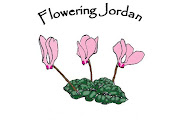Heading south, our second stop was the ruins of Ataroth, the ancient city of Northern Moab established by the Gadites and Reubenites who, seeing that it was a good place to raise livestock, were happy to settle in the area east of the Jordan Valley rather than cross into the promised land (Numbers 32). The Numbers account agrees with the only extra-Biblical artifact to mention Atoroth, the Mesha Stone, also know as the Moabite stone. More on the Mesha stone when we arrive in Diban, about 17 km southeast of Ataroth, home of the Mobite king, Mesha, in the mid-ninth century B.C.
The entire section of the Mesha stone dealing with Atoroth reads as follows:
 We headed down into a cave which was probably used for livestock, though we all agreed that it would have made a pretty nice dwelling; it was a cool reprieve from the midday heat.
We headed down into a cave which was probably used for livestock, though we all agreed that it would have made a pretty nice dwelling; it was a cool reprieve from the midday heat.
 Sunlight streaming in through a hole in the "roof" created an other-worldly beam for the the kids to play in.
Sunlight streaming in through a hole in the "roof" created an other-worldly beam for the the kids to play in.


The entire section of the Mesha stone dealing with Atoroth reads as follows:
And the men of from of old, and the king of Israel built Ataroth for himself, but I fought against the town and took it, and I slew all the people: the town belonged to Chemosh and to Moab. And I brought thence the altar-hearth of his Beloved, and I dragged it before Chemosh in Kerioth my town. And I settled in it the men of Sharon and the men of Maharath (lines 10-14).
 We headed down into a cave which was probably used for livestock, though we all agreed that it would have made a pretty nice dwelling; it was a cool reprieve from the midday heat.
We headed down into a cave which was probably used for livestock, though we all agreed that it would have made a pretty nice dwelling; it was a cool reprieve from the midday heat. Sunlight streaming in through a hole in the "roof" created an other-worldly beam for the the kids to play in.
Sunlight streaming in through a hole in the "roof" created an other-worldly beam for the the kids to play in.







1 comment:
Wow.wow.wow. What photos, my friend. That light beam is perfect...as are the ones with your children. Nice job.
Keep those stories coming. Glad that you made it to June. I, too, am relieved.
Love,
Diane
Post a Comment